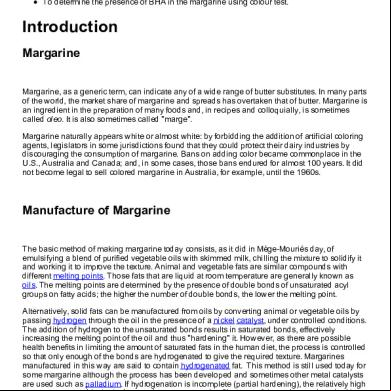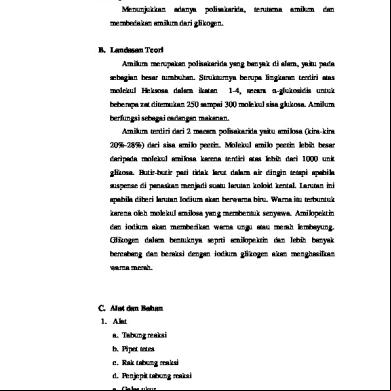Margarine Iodine Test 4fe3x
This document was ed by and they confirmed that they have the permission to share it. If you are author or own the copyright of this book, please report to us by using this report form. Report 3b7i
Overview 3e4r5l
& View Margarine Iodine Test as PDF for free.
More details w3441
- Words: 1,131
- Pages: 5
Objectives: To determine the iodine number of a selected brand of margarine. To determine the presence of BHA in the margarine using colour test.
Introduction Margarine Margarine, as a generic term, can indicate any of a wide range of butter substitutes. In many parts of the world, the market share of margarine and spreads has overtaken that of butter. Margarine is an ingredient in the preparation of many foods and, in recipes and colloquially, is sometimes called oleo. It is also sometimes called "marge". Margarine naturally appears white or almost white: by forbidding the addition of artificial coloring agents, legislators in some jurisdictions found that they could protect their dairy industries by discouraging the consumption of margarine. Bans on adding color became commonplace in the U.S., Australia and Canada; and, in some cases, those bans endured for almost 100 years. It did not become legal to sell colored margarine in Australia, for example, until the 1960s.
Manufacture of Margarine The basic method of making margarine today consists, as it did in Mège-Mouriés day, of emulsifying a blend of purified vegetable oils with skimmed milk, chilling the mixture to solidify it and working it to improve the texture. Animal and vegetable fats are similar compounds with different melting points. Those fats that are liquid at room temperature are generally known as oils. The melting points are determined by the presence of double bonds of unsaturated acyl groups on fatty acids; the higher the number of double bonds, the lower the melting point. Alternatively, solid fats can be manufactured from oils by converting animal or vegetable oils by ing hydrogen through the oil in the presence of a nickel catalyst, under controlled conditions. The addition of hydrogen to the unsaturated bonds results in saturated bonds, effectively increasing the melting point of the oil and thus "hardening" it. However, as there are possible health benefits in limiting the amount of saturated fats in the human diet, the process is controlled so that only enough of the bonds are hydrogenated to give the required texture. Margarines manufactured in this way are said to contain hydrogenated fat. This method is still used today for some margarine although the process has been developed and sometimes other metal catalysts are used such as palladium. If hydrogenation is incomplete (partial hardening), the relatively high temperatures used in the hydrogenation process tend to flip some of the carbon-carbon double bonds into the "trans" form. If these particular bonds aren't hydrogenated during the process, they will still be present in the final margarine in molecules of trans fats, the consumption of which has been shown to be a risk factor for cardiovascular disease. For this reason, partially hardened fats are used less and less in the margarine industry. Some tropical oils, such as palm oil and coconut oil, are naturally semi solid and do not require hydrogenation.
The Iodine Number The iodine value or iodine number in chemistry is the mass of iodine in grams that is consumed by 100 grams of a chemical substance. An iodine solution is yellow/brown in color and any chemical group in the substance that reacts with iodine will make the color disappear at a precise concentration. The amount of iodine solution thus required to keep the solution yellow/brown is a measure of the amount of iodine sensitive reactive groups. One application of the iodine number is the determination of the amount of unsaturation contained in fatty acids. This unsaturation is in the form of double bonds which react with iodine compounds. The higher the iodine number, the more unsaturated fatty acid bonds are present in a fat. In a typical procedure the acid is treated with an excess of the Hanus solution which is a solution of iodobromine (BrI) (or Wij's iodine solution which a solution of iodine monochloride (ICl) in glacial acetic acid). Unreacted iodobromine is reacted with potassium iodide which converts it to iodine. The iodine concentration is then determined by titration with sodium thiosulfate.
Other components in Margarine Margarine contains other components – the most important being water, by not more than 16% by weight. It also contains added Vitamins A and D and an antioxidant, usually BHA, which is a mixture of two isomers:
Procedure Iodine Number Test 1. About 200 mg of the margarine is weighed out accurately using an analytical balance on a small square of aluminum foil and this sample is dropped into a 250 ml conical flask. 2. The margarine is dissolved in 15 ml of chloroform and then 20 ml of the Hanus iodine solution is added into the flask. 3. The flask is stoppered and left to stand for 30 minutes with occasional shaking. 4. At the end of this period, 10 ml of 15% potassium iodide solution and 25 ml of distilled
5. 6. 7. 8.
water are added into the reaction mixture. The remaining iodine is titrated with 0.1M sodium thiosulphate solution, which will change the colour of the solution from yellow to colourless using a 50 ml burette. A blank determination is carried out by taking a second 20 ml portion of the Hanus solution, added with potassium iodide solution and water. The blank solution is titrated with the sodium thiosulphate solution. The iodine number is calculated.
Antioxidant Test 1. About 20 mg of margarine is dissolved in 1 ml of chloroform in a small test tube. 2. 4 drops of 1% 2,2-bipyridyl solution and 1 drop of ferric chloride solution is added. The test tube is shook for a minute. 3. The formation of pinkish colouration or precipitate gives a positive test for the antioxidant BHA.
Results Only one margarine sample was tested. The name of brand is Cap Toucan.
The Iodine Number The data obtained from titration of the sample with 0.1M sodium thiosulphate solution. Final volume (ml) Initial volume (ml) Volume required (ml)
Sample solution 20.0 1.0 19.0
Blank solution 41.3 10.0 31.3
Based on the data obtained, we can see that the amount of sodium thiosulphate solution required to titrate the blank solution is more than the amount required by the sample. The iodine number is calculated based on the equations given below. 2 Na2S2O3 + I2
Na2S4O6 + 2 NaI
Where, B is the titre for the blank: 31.3 ml M is the molarity of Na2S2O3 solution: 0.1M S is the titre of the sample: 19.0 ml W is the weight of the sample: 216.6 g
The iodine number of this brand of margarine is 0.007212.
The Antioxidant Test After one minute, pink precipitate formed on the surface of the solution and the solution turned into pink solution. Therefore, test is positive and BHA is present in the margarine.
Conclusion The Margarine Cap Toucan contained an iodine number of 0.007212 and BHA test proves to be positive.
Introduction Margarine Margarine, as a generic term, can indicate any of a wide range of butter substitutes. In many parts of the world, the market share of margarine and spreads has overtaken that of butter. Margarine is an ingredient in the preparation of many foods and, in recipes and colloquially, is sometimes called oleo. It is also sometimes called "marge". Margarine naturally appears white or almost white: by forbidding the addition of artificial coloring agents, legislators in some jurisdictions found that they could protect their dairy industries by discouraging the consumption of margarine. Bans on adding color became commonplace in the U.S., Australia and Canada; and, in some cases, those bans endured for almost 100 years. It did not become legal to sell colored margarine in Australia, for example, until the 1960s.
Manufacture of Margarine The basic method of making margarine today consists, as it did in Mège-Mouriés day, of emulsifying a blend of purified vegetable oils with skimmed milk, chilling the mixture to solidify it and working it to improve the texture. Animal and vegetable fats are similar compounds with different melting points. Those fats that are liquid at room temperature are generally known as oils. The melting points are determined by the presence of double bonds of unsaturated acyl groups on fatty acids; the higher the number of double bonds, the lower the melting point. Alternatively, solid fats can be manufactured from oils by converting animal or vegetable oils by ing hydrogen through the oil in the presence of a nickel catalyst, under controlled conditions. The addition of hydrogen to the unsaturated bonds results in saturated bonds, effectively increasing the melting point of the oil and thus "hardening" it. However, as there are possible health benefits in limiting the amount of saturated fats in the human diet, the process is controlled so that only enough of the bonds are hydrogenated to give the required texture. Margarines manufactured in this way are said to contain hydrogenated fat. This method is still used today for some margarine although the process has been developed and sometimes other metal catalysts are used such as palladium. If hydrogenation is incomplete (partial hardening), the relatively high temperatures used in the hydrogenation process tend to flip some of the carbon-carbon double bonds into the "trans" form. If these particular bonds aren't hydrogenated during the process, they will still be present in the final margarine in molecules of trans fats, the consumption of which has been shown to be a risk factor for cardiovascular disease. For this reason, partially hardened fats are used less and less in the margarine industry. Some tropical oils, such as palm oil and coconut oil, are naturally semi solid and do not require hydrogenation.
The Iodine Number The iodine value or iodine number in chemistry is the mass of iodine in grams that is consumed by 100 grams of a chemical substance. An iodine solution is yellow/brown in color and any chemical group in the substance that reacts with iodine will make the color disappear at a precise concentration. The amount of iodine solution thus required to keep the solution yellow/brown is a measure of the amount of iodine sensitive reactive groups. One application of the iodine number is the determination of the amount of unsaturation contained in fatty acids. This unsaturation is in the form of double bonds which react with iodine compounds. The higher the iodine number, the more unsaturated fatty acid bonds are present in a fat. In a typical procedure the acid is treated with an excess of the Hanus solution which is a solution of iodobromine (BrI) (or Wij's iodine solution which a solution of iodine monochloride (ICl) in glacial acetic acid). Unreacted iodobromine is reacted with potassium iodide which converts it to iodine. The iodine concentration is then determined by titration with sodium thiosulfate.
Other components in Margarine Margarine contains other components – the most important being water, by not more than 16% by weight. It also contains added Vitamins A and D and an antioxidant, usually BHA, which is a mixture of two isomers:
Procedure Iodine Number Test 1. About 200 mg of the margarine is weighed out accurately using an analytical balance on a small square of aluminum foil and this sample is dropped into a 250 ml conical flask. 2. The margarine is dissolved in 15 ml of chloroform and then 20 ml of the Hanus iodine solution is added into the flask. 3. The flask is stoppered and left to stand for 30 minutes with occasional shaking. 4. At the end of this period, 10 ml of 15% potassium iodide solution and 25 ml of distilled
5. 6. 7. 8.
water are added into the reaction mixture. The remaining iodine is titrated with 0.1M sodium thiosulphate solution, which will change the colour of the solution from yellow to colourless using a 50 ml burette. A blank determination is carried out by taking a second 20 ml portion of the Hanus solution, added with potassium iodide solution and water. The blank solution is titrated with the sodium thiosulphate solution. The iodine number is calculated.
Antioxidant Test 1. About 20 mg of margarine is dissolved in 1 ml of chloroform in a small test tube. 2. 4 drops of 1% 2,2-bipyridyl solution and 1 drop of ferric chloride solution is added. The test tube is shook for a minute. 3. The formation of pinkish colouration or precipitate gives a positive test for the antioxidant BHA.
Results Only one margarine sample was tested. The name of brand is Cap Toucan.
The Iodine Number The data obtained from titration of the sample with 0.1M sodium thiosulphate solution. Final volume (ml) Initial volume (ml) Volume required (ml)
Sample solution 20.0 1.0 19.0
Blank solution 41.3 10.0 31.3
Based on the data obtained, we can see that the amount of sodium thiosulphate solution required to titrate the blank solution is more than the amount required by the sample. The iodine number is calculated based on the equations given below. 2 Na2S2O3 + I2
Na2S4O6 + 2 NaI
Where, B is the titre for the blank: 31.3 ml M is the molarity of Na2S2O3 solution: 0.1M S is the titre of the sample: 19.0 ml W is the weight of the sample: 216.6 g
The iodine number of this brand of margarine is 0.007212.
The Antioxidant Test After one minute, pink precipitate formed on the surface of the solution and the solution turned into pink solution. Therefore, test is positive and BHA is present in the margarine.
Conclusion The Margarine Cap Toucan contained an iodine number of 0.007212 and BHA test proves to be positive.





